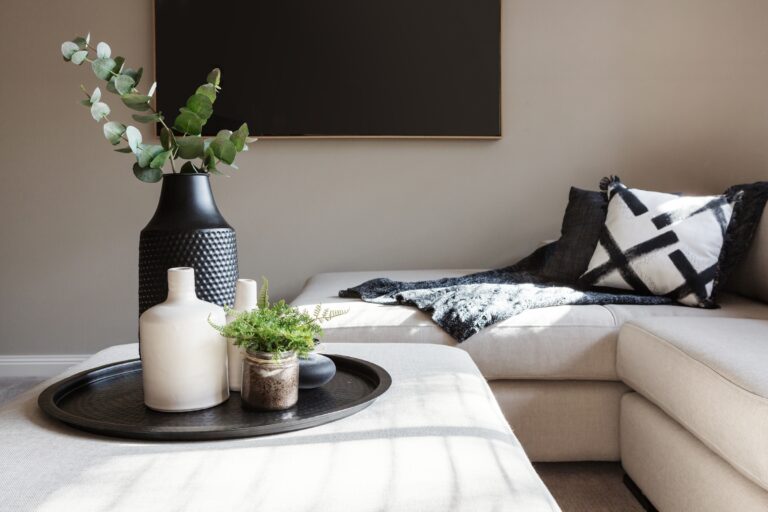Before you pop the bubbly with a new client, make sure your investment guide does the heavy lifting behind the scenes.
For any profitable designer, a clear and comprehensive investment guide is an essential part of the interior design sales process.
This powerful document helps potential clients understand what it’s like to work with you, how to budget their investment, and most importantly, why your services are worth the investment. It sets expectations, establishes financial transparency, and saves you hours of back-and-forth by answering the most common client questions before getting on a call.
In this post, we’ll break down exactly what an Interior Design Investment Guide is, what to include in yours, and where to find beautiful, done-for-you templates to help you get started fast.
Table of Contents
What is an interior design investment guide?
An interior design investment guide is a client-facing document that clearly outlines your services, pricing, and process. It includes detailed descriptions of what each service offers, transparent starting budgets, and realistic investment ranges based on project types. The guide highlights key milestones and payment timelines, while also showcasing the tangible and lifestyle benefits clients can expect. It helps pre-qualify leads by stating minimum project requirements and ends with a clear call to action to move forward with confidence.
This guide is sent to potential clients after an inquiry and before a consultation. It acts as one of your first serious touchpoints and serves one major purpose: to help clients understand what it costs to work with you, and why it’s worth it.
Why are investment guides crucial for interior designers?
Here’s why you need an investment guide:
- They pre-qualify leads: By presenting realistic pricing and investment ranges, your guide naturally filters out clients who aren’t a financial fit, saving you time on unqualified discovery calls.
- They establish financial transparency: Money is one of the biggest causes of friction in design projects. Being upfront about pricing prevents misunderstandings down the line.
- They demonstrate value: Rather than focusing on cost alone, investment guides allow you to clearly explain the value of your services, how they impact quality of life and property value, and what clients can expect to receive beyond a more stylish space.
When should these documents be sent?
Send your Investment Guide immediately after a new client inquiry—before any consultation or discovery call takes place.
Think of it as your first serious touchpoint: a professional, pre-meeting tool that gives potential clients a clear picture of your pricing, process, and value. By sending it early, you allow clients to assess whether their goals and budget align with your services, saving time on both your side and theirs.
What to include in an interior design investment guide
Your investment guide should be organized, easy to understand, and financially informative. Here’s everything we recommend including (along with examples to help you create a document of your own):
1. Introduction and positioning statement
Start with a short, confident statement about what you do and who you serve. Set the tone for why this document exists.
| Example: At [Business Name], we create beautiful, functional interiors designed to enhance your lifestyle—and your property’s long-term value. This guide outlines the financial investment, design process, and deliverables you can expect when working with us. |
Keep this brief but impactful. The goal is to frame the client’s mindset around value and outcomes, not just aesthetics.
2. Your services and associated costs
Here’s where the real financial clarity begins. List each of your service offerings, what’s included, and what clients can expect to invest.
Use pricing language intentionally:
- Starts at
- Typical investment range
- Minimum design fee
- Average room budget
| Example: Full-service design Ideal for clients looking for a comprehensive, turnkey experience. Investment: Projects typically start at $5,000 in design fees, with full furnishings ranging from $25,000–$50,000+ depending on scope. Includes: Design concept, sourcing, procurement, project coordination, styling, and installation. Virtual design package Perfect for those seeking professional direction while managing the project themselves. Investment: Flat fee of $3,000 per room. Includes: Mood boards, shopping lists, floor plans, and a single revision. |
3. Design process with payment due dates
Your process section isn’t just about what happens when—it’s a chance to highlight all of the moments when money is exchanged so there are no surprises along the way.
| Example: Phase 1: Discovery & proposal – Complimentary consultation call – Investment guide delivered – Custom proposal sent with retainer request Phase 2: Design development – Design fee invoiced upfront – Client receives concepts, plans, and selections – Revisions and approvals occur Phase 3: Procurement & project management – Furnishings and materials ordered – Procurement fee or purchasing commission applied – Client signs off on final budget before orders are placed Phase 4: Installation & reveal – Final styling and walkthrough – Photography scheduled – Remaining balances due |
4. Client ROI and value proposition
After covering the costs in the last section, use this space to highlight the financial benefits your clients can expect. Note that your services will support your client by:
- Maximizing their budget
- Avoiding expensive mistakes
- Increasing their property value
- Saving time and reducing stress throughout the project
| Example: Our clients don’t just end up with beautiful spaces—they get help making wise financial decisions, sticking to a budget, and ending up with a space that fits their life, and boosts their home’s potential value. |
You can also include stats here, like:
- “Minor kitchen remodels have an average ROI of 96%”
- “Professionally staged homes sell 73% faster and for 6–10% more”
- “Homes with well-designed interiors often appraise higher due to quality finishes and spatial improvements”
5. Client testimonials that emphasize ROI
We also recommend including short testimonials that not only speak to your talent—but reinforce the idea of investment and value.
Look through your testimonials for comments that mention:
- Time saved
- Money well spent
- Increased home value
- Greater daily enjoyment
| Example: Hiring [Designer] was the best investment we made during our renovation. She helped us stick to our budget, avoid expensive mistakes, and the final result blew away our real estate agent. |
6. Minimum project budgets
To prevent scope misunderstandings and wasted time, be clear about your minimum requirements.
| Example: Minimum design fee: $7,500 Minimum furnishings budget for full-service: $50,000 Design-only projects not accepted at this time |
If you want to create flexibility, you can include a note like this:
Not sure where your project fits? Reach out—we’ll help you assess whether your scope and budget align with our services.
7. Next steps and call to action
Wrap up your guide with a clear, professional path forward. Encourage the client to sign on only if they feel aligned with your process and budget.
| Example: If this investment range aligns with your expectations and you’re ready to move forward, let’s schedule a discovery call. We’ll review your goals, budget, timeline, and the ideas we have to bring your vision to life. |
5 investment guide templates
As important as investment guides are, they’re not always easy to squeeze into the busy schedule of an interior designer. Thankfully, there’s no need to start from scratch.
There are dozens of well-designed, professional templates available online that are fully customizable and reasonably priced. These resources are built specifically for interior designers and include everything you need to communicate your services, pricing, and process with clearly and confidently.
We’ve rounded up five of the best interior design investment guide templates available today. Read on to find your ideal fit.
1. Dakota Design Co’s Full Service Interior Design Investment Guide
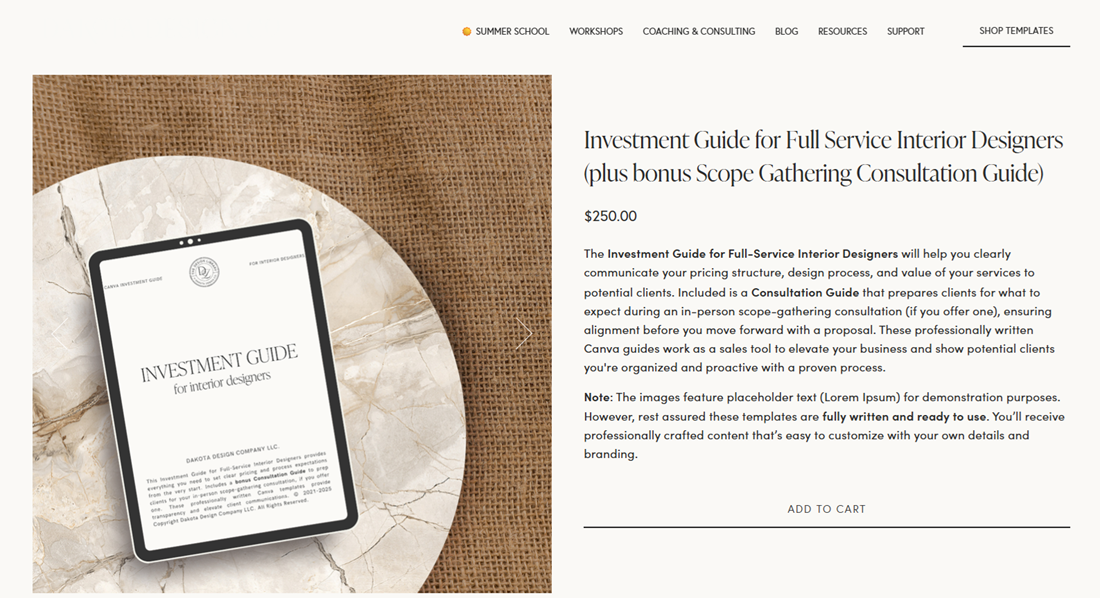
Price: $250
Dakota Design Co’s 16-page investment guide outlines your design process, pricing structure, and the value of your services. It includes sections on your team, mission, budget expectations, FAQs, and next steps—everything you need to set clear client expectations. As a bonus, it comes with a free editable consultation guide to further streamline your onboarding process.
2. Gallo Investment & Services Guide by Sonderpath Studio
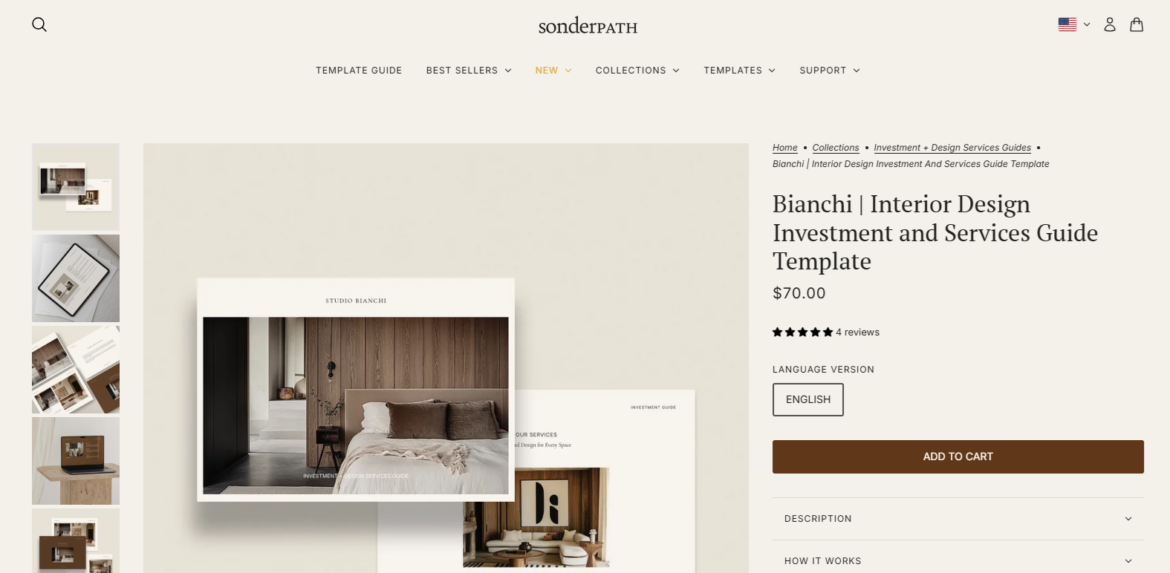
Price: $69
This 21-page Sonderpath Studio document is both comprehensive and affordable. It’s editable in Canva, PowerPoint, and Adobe InDesign, which means you can stick to the platform you’re most comfortable with. It features flexible layouts, customizable branding, and pre-written copy that clearly explains your process and pricing, making it ready to use right out of the box.
3. Various Investment Guide by IDCO Studio
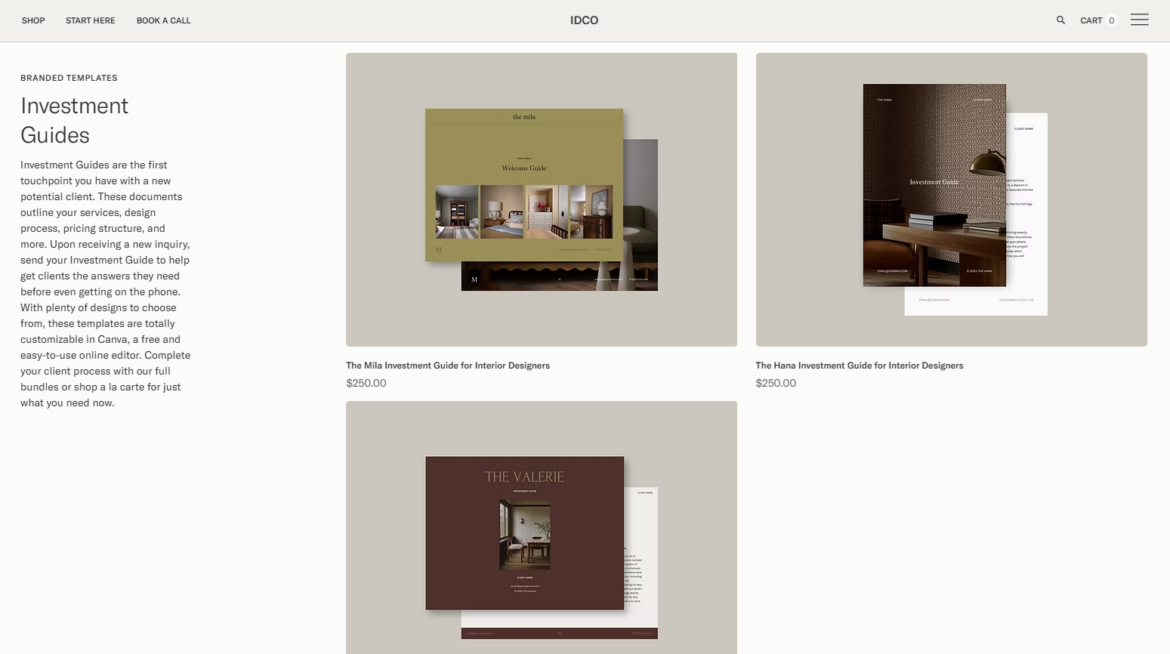
Prices: $250.00
IDCO Studio offers a range of investment guide templates, so you can choose one that fits your brand aesthetic. Each template includes thoughtfully designed sections for services, process, and pricing, along with content prompts to help you write with clarity. As a bonus, they include a free tool to help you attract more qualified leads.
4. Casa Ren Studio Investment Guide
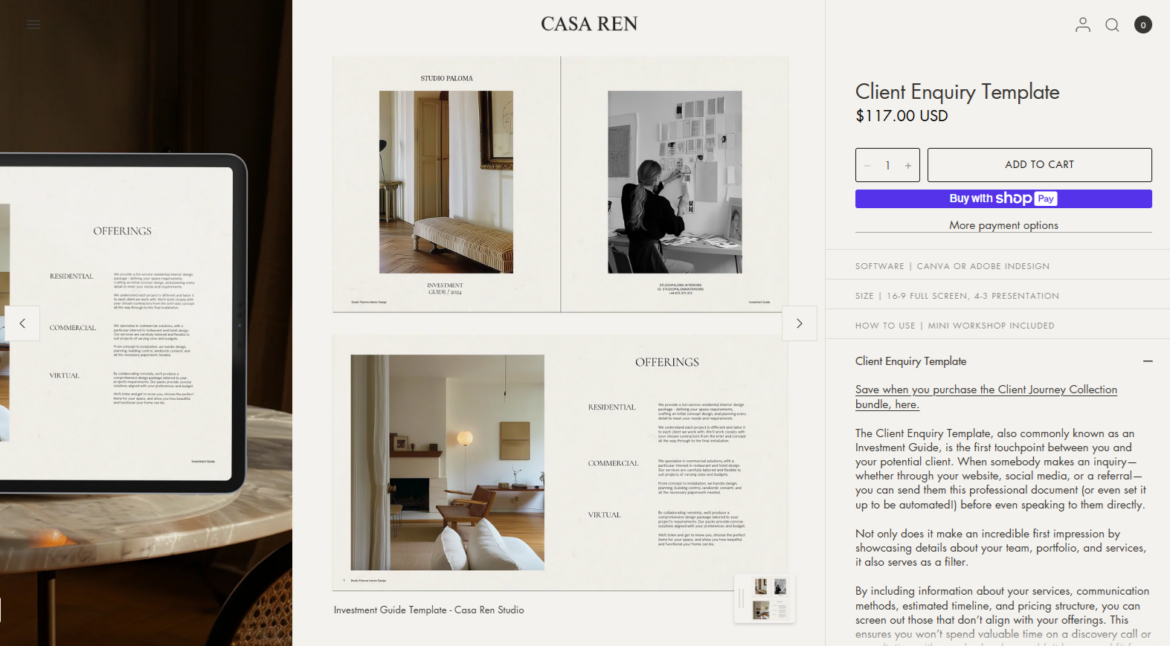
Price: $117
This 23-page guide from Casa Ren Studio includes a mini video workshop, making it especially helpful for newer designers. Fully customizable in Canva or Adobe InDesign, it’s the exact version Casa Ren uses with their own clients, so the content is clear, client-tested, and ready to use.
5. Insight Design Studio’s Etsy Investment Guide
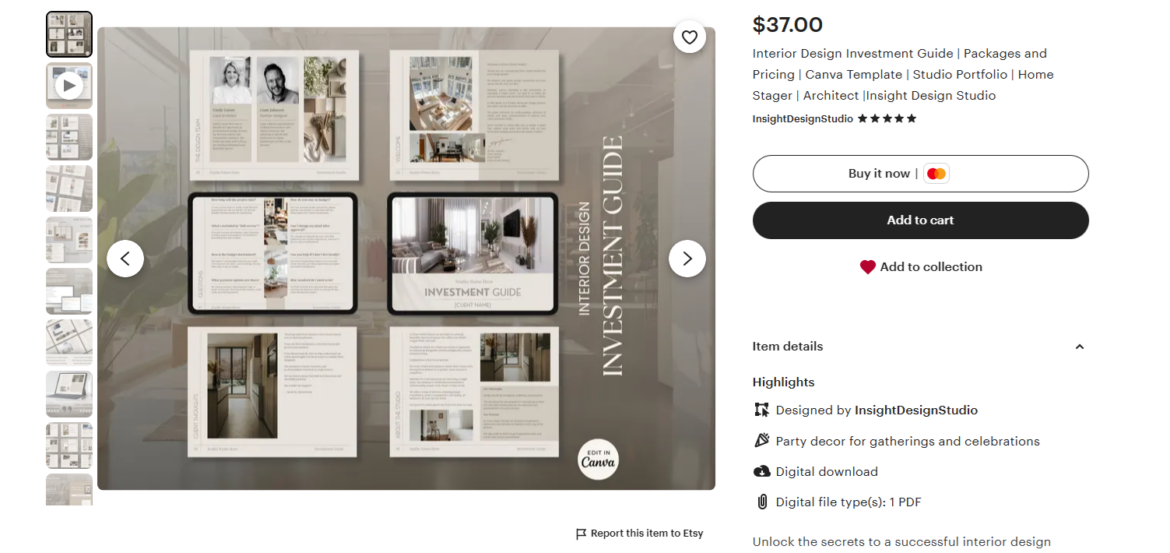
Price: $37
Don’t let the low price fool you—this template is designed to attract high-value clients. It includes space to showcase your portfolio alongside a full investment guide, adding even more impact to your presentation. Available as an instant Canva download, it’s easy to personalize and put to work right away. Check out its nearly 300 5-star reviews to learn more.
No matter which template you choose, you’re moving toward a more polished, client-ready business. If you’re building out the rest of your documents, don’t miss DesignFiles’ free expert guides on creating interior design proposals and contracts.
Streamline client communication with DesignFiles
With the right investment guide in place, you’ll be equipped to attract aligned clients, communicate your value clearly, and start each project with confidence. If you’re ready to streamline your entire client experience—from services and pricing to proposals, contracts, and product sourcing—DesignFiles makes it all beautifully simple. With done-for-you templates, intuitive tools, and a built-in product clipper, it’s everything you need to turn inquiries into dream projects.
Start your free trial of DesignFiles. Use it as long as you’d like for a single project.


